文章
Dummer. ゛☀
2017年08月10日

Many of us are familiar with cyclamen as a charming florist’s plant that brightens up the indoor environment during the gloomy winter months. What we may not realize, however, is that cyclamen, a cousin to the cheery little primrose, is actually native to the Mediterranean and surrounding areas. In the home garden, cyclamen is often grown in woodland settings, although many types of cyclamen plants thrive in Alpine meadows. The typical florist cyclamen (Cyclamen persicum) is only one of many cyclamen plant types. In fact, there are more than 20 species within the genus. Read on for a small sampling of cyclamen plant types and cyclamen varieties.
Cyclamen Plant Types and Cyclamen Varieties
Cyclamen heredifolium, also known as ivy-leaved cyclamen, is a robust species that tolerates relatively cold winters. In the United States, it has naturalized in parts of the Pacific Northwest. This autumn-flowering species, popular and easy to grow in the home garden, blooms in shades of pink or white tinged with pink. Grow C. heredifolium in Zones 5 through 7. Cyclamen varieties within this species include: ‘Nettleton Silver’ ‘Pewter White’ ‘Silver Arrow’‘Silver Cloud’ ‘Bowle’s Apollo’ ‘White Cloud’ Cyclamen coum sports quarter-sized green or patterned, rounded or heart-shaped leaves that typically appear in autumn. Small, bright flowers poke up through the foliage in midwinter. This species is hardy to USDA zones 6 and above.
Varieties of C. coum include several cultivars within the ‘Pewter Leaf’ group as well as the following: ‘Album’ ‘Maurice Dryden’ ‘Something Magic’ ‘Rubrum’ ‘Silver Leaf’ ‘Blush’ Cyclamen graecum can be difficult to grow and often isn’t as vigorous as other varieties. However, this species is stunning, with velvety, deep green foliage in vivid colors and patterns. Tiny blooms, sometimes sweetly scented, rise just above the foliage in late summer and autumn. This tender variety is suitable for zones 7 through 9. Cyclamen plant varieties within the C. graecum species include ‘Glyfada’ and ‘Rhodopou.’
Cyclamen mirabile is a charming fall bloomer that produces dainty little flowers and decorative, silver dollar-sized leaves in patterns of green and silver. This species grows in zones 6 through 8. Varieties of C. mirabile include ‘Tilebarn Ann,’ ‘Tilebarn Nicholas’ and ‘Tilebarn Jan.’

Cyclamen Plant Types and Cyclamen Varieties
Cyclamen heredifolium, also known as ivy-leaved cyclamen, is a robust species that tolerates relatively cold winters. In the United States, it has naturalized in parts of the Pacific Northwest. This autumn-flowering species, popular and easy to grow in the home garden, blooms in shades of pink or white tinged with pink. Grow C. heredifolium in Zones 5 through 7. Cyclamen varieties within this species include: ‘Nettleton Silver’ ‘Pewter White’ ‘Silver Arrow’‘Silver Cloud’ ‘Bowle’s Apollo’ ‘White Cloud’ Cyclamen coum sports quarter-sized green or patterned, rounded or heart-shaped leaves that typically appear in autumn. Small, bright flowers poke up through the foliage in midwinter. This species is hardy to USDA zones 6 and above.

Varieties of C. coum include several cultivars within the ‘Pewter Leaf’ group as well as the following: ‘Album’ ‘Maurice Dryden’ ‘Something Magic’ ‘Rubrum’ ‘Silver Leaf’ ‘Blush’ Cyclamen graecum can be difficult to grow and often isn’t as vigorous as other varieties. However, this species is stunning, with velvety, deep green foliage in vivid colors and patterns. Tiny blooms, sometimes sweetly scented, rise just above the foliage in late summer and autumn. This tender variety is suitable for zones 7 through 9. Cyclamen plant varieties within the C. graecum species include ‘Glyfada’ and ‘Rhodopou.’

Cyclamen mirabile is a charming fall bloomer that produces dainty little flowers and decorative, silver dollar-sized leaves in patterns of green and silver. This species grows in zones 6 through 8. Varieties of C. mirabile include ‘Tilebarn Ann,’ ‘Tilebarn Nicholas’ and ‘Tilebarn Jan.’
1
0
文章
Dummer. ゛☀
2017年08月10日

Although there are more than 20 species of cyclamen, florist’s cyclamen (Cyclamen persicum) is the most familiar, typically given as gifts to brighten up the indoor environment during late winter’s gloom. This little charmer is especially popular around Christmas and Valentine’s Day, but what about caring for cyclamen after flowering? If you’ve been wondering how to treat cyclamen after blooming, read on to learn how to do just that!
Keeping Cyclamen After Blooms Fade
What to do with a cyclamen after flowering? Often, florist’s cyclamen is considered a seasonal gift. It can be difficult to get a cyclamen to rebloom, so the plant is frequently discarded after it has lost its beauty. Although keeping cyclamens after blooms fade is a bit of a challenge, it’s definitely possible. Proper light and temperature are the keys to caring for cyclamen after flowering.
How to Treat Cyclamen After Blooming
It’s normal for cyclamen to lose its leaves and go dormant after flowering. The plant requires a period of dormancy during the summer so the tuberous root has time to re-energize for the coming blooming season. Here are the steps: Gradually cut back on watering when the leaves begin to wilt and turn yellow. Use scissors to remove all remaining dead and dying foliage. Place the tuber in a container with the top half of the tuber sitting above the surface of the soil. Put the container in a cool, shady room, away from bright or direct light. Be sure the plant isn’t exposed to frost.
Withhold water and fertilizer during the dormant period – generally six to eight weeks. Watering during dormancy will rot the tuber. As soon as you see new growth sometime between September and December, move the cyclamen into bright sunlight and water the plant thoroughly. Keep the cyclamen in a cool room with daytime temperatures between 60 and 65 F. (16-18 C.), and nighttime temps at about 50 F. (10 C.). Feed the plant monthly, using a liquid fertilizer for indoor plants. Watch for the cyclamen to rebloom in midwinter, as long as conditions are just right.

Keeping Cyclamen After Blooms Fade
What to do with a cyclamen after flowering? Often, florist’s cyclamen is considered a seasonal gift. It can be difficult to get a cyclamen to rebloom, so the plant is frequently discarded after it has lost its beauty. Although keeping cyclamens after blooms fade is a bit of a challenge, it’s definitely possible. Proper light and temperature are the keys to caring for cyclamen after flowering.

How to Treat Cyclamen After Blooming
It’s normal for cyclamen to lose its leaves and go dormant after flowering. The plant requires a period of dormancy during the summer so the tuberous root has time to re-energize for the coming blooming season. Here are the steps: Gradually cut back on watering when the leaves begin to wilt and turn yellow. Use scissors to remove all remaining dead and dying foliage. Place the tuber in a container with the top half of the tuber sitting above the surface of the soil. Put the container in a cool, shady room, away from bright or direct light. Be sure the plant isn’t exposed to frost.

Withhold water and fertilizer during the dormant period – generally six to eight weeks. Watering during dormancy will rot the tuber. As soon as you see new growth sometime between September and December, move the cyclamen into bright sunlight and water the plant thoroughly. Keep the cyclamen in a cool room with daytime temperatures between 60 and 65 F. (16-18 C.), and nighttime temps at about 50 F. (10 C.). Feed the plant monthly, using a liquid fertilizer for indoor plants. Watch for the cyclamen to rebloom in midwinter, as long as conditions are just right.
0
0
文章
Dummer. ゛☀
2017年08月10日

Croton plants (Codiaeum variegatum) are incredibly varied plants that are often grown as houseplants. The croton indoor plant has a reputation for being fussy, but in reality, if you know about caring for a croton houseplant properly, it can make for a resilient and hard-to-kill plant.
Croton Indoor Plant
The croton plant is often grown outdoors in tropical climates, but also make excellent houseplants. Crotons come in a wide variety of leaf shapes and colors. Leaves can be short, long, twisted, thin, thick and several of these combined. Colors range from green, variegated, yellow, red, orange, cream, pink and black to a combination of all these. It is safe to say that if you look hard enough, you will find a croton that matches your décor. When considering croton growing, check the variety you have purchased to determine the light needs of your specific variety. Some varieties of croton need high light while others need medium or low light. In general, the more variegated and colorful the croton plant, the more light it will need.
Tips on the Care of Croton Plants
Part of the reason that these plants have a reputation for being fussy is because they tend to make a bad first impression. Oftentimes, a person will bring home a new croton from the store and within days, the plant will have lost some and maybe all of its foliage. This leaves the new owner wondering, “How did I fail in caring for a croton houseplant?” The short answer is that you did not fail; this is normal croton behavior. Croton plants do not like to be moved, and when they are moved, they can quickly go into shock which results in leaf loss. Therefore, it’s best to avoid moving the plant as much as possible. In situations where moving the plant is unavoidable (such as when you buy one), don’t panic at the leaf loss. Simply maintain proper care and the plant will regrow its leaves within a short period of time, after which, it will prove to be a resilient houseplant.
Like many houseplants, caring for a croton involves proper watering and humidity. Because it is a tropical plant, it does benefit from high humidity, so placing it on a pebble tray or regular misting will help keep it looking its best. Croton growing in containers should only be watered only when the top of the soil is dry to the touch. Then, they should be watered until the water flows out the bottom of the container. The plant should also be kept away from drafts and cold, as it cannot tolerate temperatures below 60 F. (15 C.). If it is exposed to temps lower than this, the croton will lose leaves and possibly die.

Croton Indoor Plant
The croton plant is often grown outdoors in tropical climates, but also make excellent houseplants. Crotons come in a wide variety of leaf shapes and colors. Leaves can be short, long, twisted, thin, thick and several of these combined. Colors range from green, variegated, yellow, red, orange, cream, pink and black to a combination of all these. It is safe to say that if you look hard enough, you will find a croton that matches your décor. When considering croton growing, check the variety you have purchased to determine the light needs of your specific variety. Some varieties of croton need high light while others need medium or low light. In general, the more variegated and colorful the croton plant, the more light it will need.

Tips on the Care of Croton Plants
Part of the reason that these plants have a reputation for being fussy is because they tend to make a bad first impression. Oftentimes, a person will bring home a new croton from the store and within days, the plant will have lost some and maybe all of its foliage. This leaves the new owner wondering, “How did I fail in caring for a croton houseplant?” The short answer is that you did not fail; this is normal croton behavior. Croton plants do not like to be moved, and when they are moved, they can quickly go into shock which results in leaf loss. Therefore, it’s best to avoid moving the plant as much as possible. In situations where moving the plant is unavoidable (such as when you buy one), don’t panic at the leaf loss. Simply maintain proper care and the plant will regrow its leaves within a short period of time, after which, it will prove to be a resilient houseplant.

Like many houseplants, caring for a croton involves proper watering and humidity. Because it is a tropical plant, it does benefit from high humidity, so placing it on a pebble tray or regular misting will help keep it looking its best. Croton growing in containers should only be watered only when the top of the soil is dry to the touch. Then, they should be watered until the water flows out the bottom of the container. The plant should also be kept away from drafts and cold, as it cannot tolerate temperatures below 60 F. (15 C.). If it is exposed to temps lower than this, the croton will lose leaves and possibly die.
0
0
文章
Dummer. ゛☀
2017年08月10日

Your brilliant indoor croton plant, the one you admire and prize, is now dropping leaves like crazy. Don’t panic. Leaf drop on croton plants can be expected any time the plant is stressed or out of balance. You just need to get to know your croton and how to give croton what it needs to thrive. Read on to learn more about why croton leaves fall off.
Why is My Croton Dropping Leaves?
Change can be difficult for a croton plant. A croton plant dropping leaves is often a new plant’s response to being transplanted or transported from the greenhouse to your home. It’s natural for a croton to drop leaves as it adjusts to environmental changes. Once settled, in three or four weeks, your plant will begin to produce new growth. If you haven’t changed the plant’s location recently and your croton leaves fall off, then it’s time to look at other possibilities. Heat and humidity – Croton plants are tropicals, meaning they thrive in warm and humid conditions. If your croton’s leaves fall off, it could be that it’s exposed to cold or hot extremes such as open doors or air ducts. A humidifier or a regular misting with distilled water will also help your croton feel at home. Light – Croton leaf drop and a lack of fiery color can be caused by insufficient sunlight. There are more than 750 varieties of croton plant, some needing more light than others. In general, the more variegated the plant, the more light it craves.
Water – The watering schedule for your other houseplants may not be suitable for your croton. Overwatering can damage the roots and cause croton leaf drop. When the soil on top feels dry, water until the overflow begins to pool in the tray. To prevent root rot, use a pebbled tray or pour off any pooled water after 30 minutes. Underwatering can also cause leaf drop on croton plants. If you’re watering and misting consistently and your croton still seems dry, consider transplanting in fresh, high-quality potting soil that includes peat moss to help retain moisture. Diseases and pests – If you think you’ve taken care of every possible environmental reason your croton plant is dropping leaves, look again. Inspect underneath the leaves for signs of disease or insect pests and treat accordingly.
Here’s the best news: crotons are tough. Even if your croton is brown and leafless, it doesn’t mean that your lovely plant is gone forever. Gently scratch the main stem. If the tissue underneath is still green, your plant is alive and may recover. Continue to care for your plant’s watering and environmental needs. In several weeks, it’s quite likely that your patience and care will be rewarded with the first of new, bright leaves.

Why is My Croton Dropping Leaves?
Change can be difficult for a croton plant. A croton plant dropping leaves is often a new plant’s response to being transplanted or transported from the greenhouse to your home. It’s natural for a croton to drop leaves as it adjusts to environmental changes. Once settled, in three or four weeks, your plant will begin to produce new growth. If you haven’t changed the plant’s location recently and your croton leaves fall off, then it’s time to look at other possibilities. Heat and humidity – Croton plants are tropicals, meaning they thrive in warm and humid conditions. If your croton’s leaves fall off, it could be that it’s exposed to cold or hot extremes such as open doors or air ducts. A humidifier or a regular misting with distilled water will also help your croton feel at home. Light – Croton leaf drop and a lack of fiery color can be caused by insufficient sunlight. There are more than 750 varieties of croton plant, some needing more light than others. In general, the more variegated the plant, the more light it craves.

Water – The watering schedule for your other houseplants may not be suitable for your croton. Overwatering can damage the roots and cause croton leaf drop. When the soil on top feels dry, water until the overflow begins to pool in the tray. To prevent root rot, use a pebbled tray or pour off any pooled water after 30 minutes. Underwatering can also cause leaf drop on croton plants. If you’re watering and misting consistently and your croton still seems dry, consider transplanting in fresh, high-quality potting soil that includes peat moss to help retain moisture. Diseases and pests – If you think you’ve taken care of every possible environmental reason your croton plant is dropping leaves, look again. Inspect underneath the leaves for signs of disease or insect pests and treat accordingly.

Here’s the best news: crotons are tough. Even if your croton is brown and leafless, it doesn’t mean that your lovely plant is gone forever. Gently scratch the main stem. If the tissue underneath is still green, your plant is alive and may recover. Continue to care for your plant’s watering and environmental needs. In several weeks, it’s quite likely that your patience and care will be rewarded with the first of new, bright leaves.
0
0
文章
Dummer. ゛☀
2017年08月10日

While most houseplants require a bit of effort in providing appropriate growing conditions (light, temperature, humidity, etc.), growing Chinese evergreens can make even the novice indoor gardener look like an expert. This tropical foliage plant is one of the most durable houseplants you can grow, tolerating poor light, dry air and drought.
Tips for Growing Chinese Evergreens Indoors
Growing Chinese evergreens (Aglaonema) is easy. This gem of a plant is one of the most popular houseplants grown in the home due to its ease of care. You can find Chinese evergreen plants in many varieties, including variegated forms. Although they are tolerant of many growing conditions, following certain recommendations will yield greater results. This includes placing them in well-draining soil, preferably an equal mix of potting soil, perlite and sand. Chinese evergreen plants thrive in medium to low light conditions, or indirect sunlight. Wherever you place it in the home, you should make sure that the plant receives warm temps and somewhat humid conditions. However, this flexible plant will tolerate less than ideal conditions if necessary. These plants prefer temperatures no lower than 60 F. (16 C.) with average indoor temps ranging between 70-72 F. (21-22 C.) being most favorable, but they can tolerate temps around 50-55 F.(10-13 C.). Keep Chinese evergreen plants away from drafts, which can cause browning of the foliage.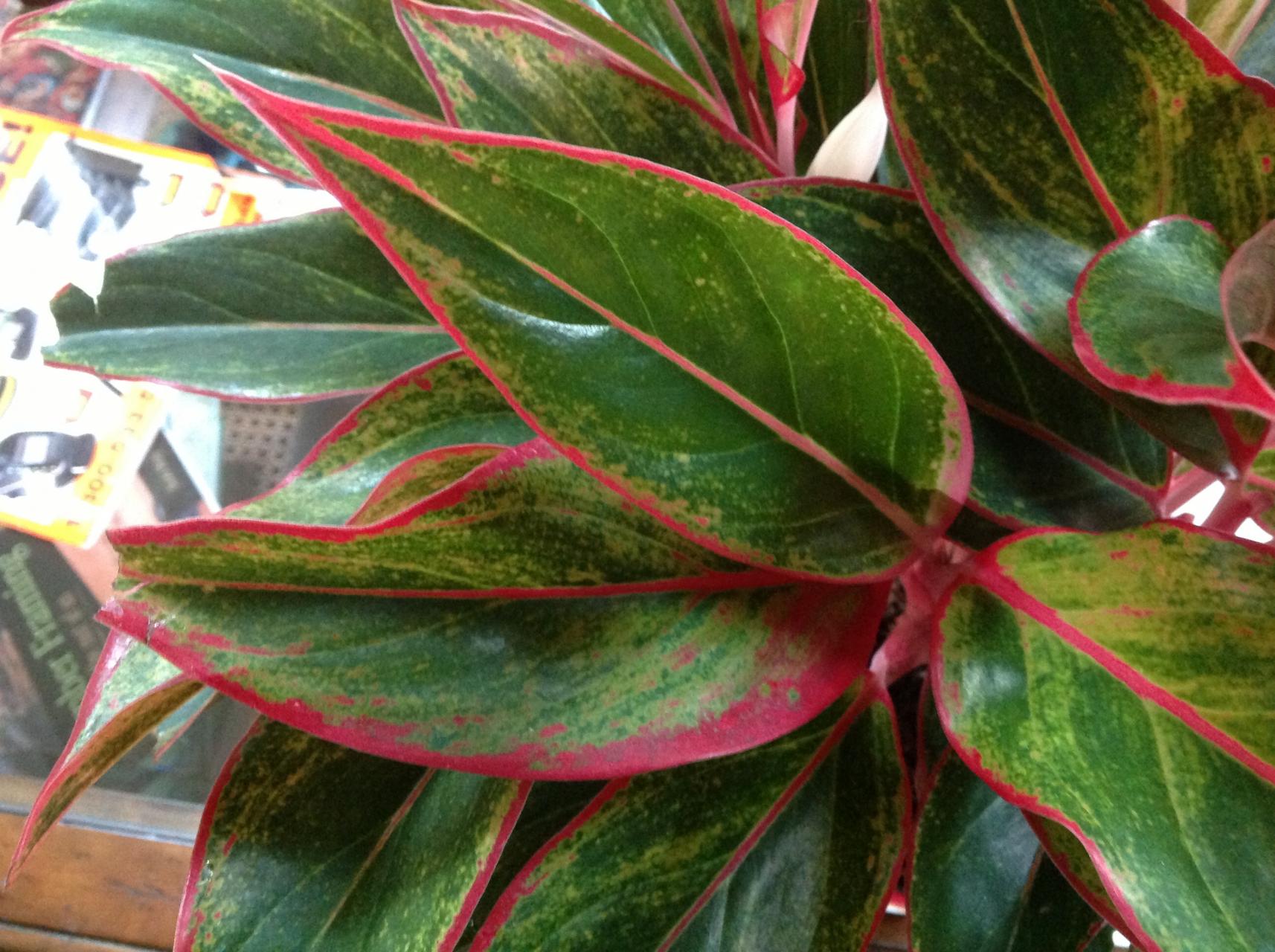
Chinese Evergreen Care
Caring for Chinese evergreen houseplants requires little effort when given the proper growing conditions. They enjoy moderate watering—not too much, not too little. Allow the plant to dry out some between watering. Overwatering will lead to root rot. As part of your Chinese evergreen care, you should fertilize older Chinese evergreens once or twice yearly using a water-soluble houseplant fertilizer. If your Chinese evergreen plant becomes too large or leggy, give the plant a quick trim. It’s also possible to save cuttings during the process for propagating new plants. Cuttings root easily in water. Older plants will sometimes produce flowers reminiscent of calla or peace lilies. This occurs in spring to summer. Most people choose to cut the blooms prior to seed productions, though you may choose to keep them and try your hand at seed growing them. Keep in mind, however, that this will take much longer.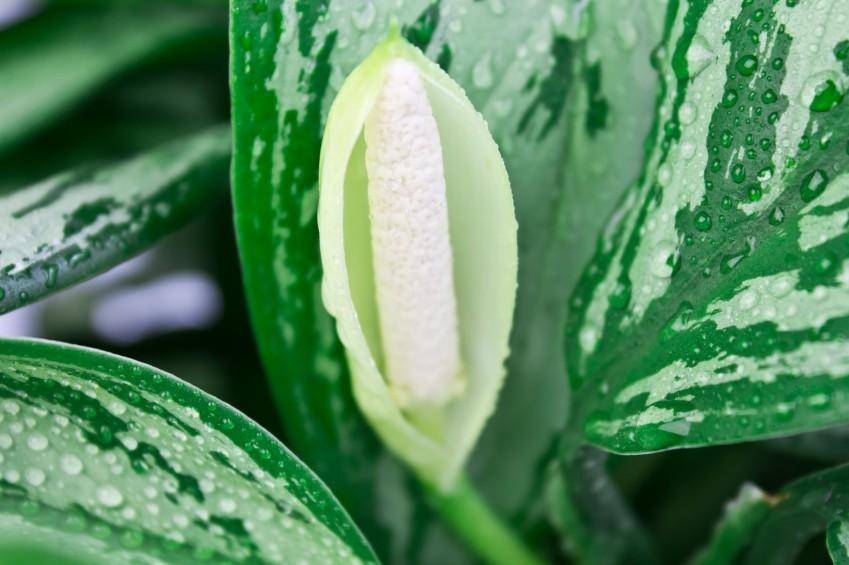
To limit the accumulation of dust build-up, clean the leaves occasionally by wiping them down with a soft, damp rag or simply place them in the shower and allow them to air dry. Chinese evergreen houseplants can be affected by spider mites, scale, mealybugs, and aphids. Routinely checking the leaves for signs of pests will help limit problems later. While it may seem overwhelming at first, especially if you are new at growing Chinese evergreens indoors, it’s actually easier than you may think.

Tips for Growing Chinese Evergreens Indoors
Growing Chinese evergreens (Aglaonema) is easy. This gem of a plant is one of the most popular houseplants grown in the home due to its ease of care. You can find Chinese evergreen plants in many varieties, including variegated forms. Although they are tolerant of many growing conditions, following certain recommendations will yield greater results. This includes placing them in well-draining soil, preferably an equal mix of potting soil, perlite and sand. Chinese evergreen plants thrive in medium to low light conditions, or indirect sunlight. Wherever you place it in the home, you should make sure that the plant receives warm temps and somewhat humid conditions. However, this flexible plant will tolerate less than ideal conditions if necessary. These plants prefer temperatures no lower than 60 F. (16 C.) with average indoor temps ranging between 70-72 F. (21-22 C.) being most favorable, but they can tolerate temps around 50-55 F.(10-13 C.). Keep Chinese evergreen plants away from drafts, which can cause browning of the foliage.

Chinese Evergreen Care
Caring for Chinese evergreen houseplants requires little effort when given the proper growing conditions. They enjoy moderate watering—not too much, not too little. Allow the plant to dry out some between watering. Overwatering will lead to root rot. As part of your Chinese evergreen care, you should fertilize older Chinese evergreens once or twice yearly using a water-soluble houseplant fertilizer. If your Chinese evergreen plant becomes too large or leggy, give the plant a quick trim. It’s also possible to save cuttings during the process for propagating new plants. Cuttings root easily in water. Older plants will sometimes produce flowers reminiscent of calla or peace lilies. This occurs in spring to summer. Most people choose to cut the blooms prior to seed productions, though you may choose to keep them and try your hand at seed growing them. Keep in mind, however, that this will take much longer.

To limit the accumulation of dust build-up, clean the leaves occasionally by wiping them down with a soft, damp rag or simply place them in the shower and allow them to air dry. Chinese evergreen houseplants can be affected by spider mites, scale, mealybugs, and aphids. Routinely checking the leaves for signs of pests will help limit problems later. While it may seem overwhelming at first, especially if you are new at growing Chinese evergreens indoors, it’s actually easier than you may think.
0
0
文章
Dummer. ゛☀
2017年08月10日

The flaming sword houseplant, Vriesea splendens, is one of the most common bromeliads used for indoor decoration and is one of the showiest. You may already have one in your houseplant collection and wonder how to grow flaming sword plants. Vriesea flaming sword info says there are 250 varieties of Vriesea, providing a range of color in both foliage and colorful bracts. The flaming sword houseplant is commonly named for its red bracts that appear when the plant is three to five years old. It is an epiphyte in its native habitat.
How to Grow Flaming Sword Plants
The flaming sword houseplant grows best in a one to one mix of regular potting soil and orchid mix. Special soil for bromeliads is sometimes available at the local garden center. Vriesea flaming sword info indicates a special display for the plant can eliminate the need for growing in soil. Attach the plant to a slab or large piece of bark reminiscent of its native habitat to provide an interesting display.
Care of Vriesea Plants
Locate the flaming sword houseplant in bright, indirect light indoors. Allow some direct morning or evening sun in winter, if possible. Care of Vriesea plants includes keeping them in temperatures above 60 F. (16 C.), but no warmer than 80 F (27 C). As with other bromeliads, the flaming sword houseplant has a cup or tank in the middle of the plant. Keep this cup filled with water. Vriesea flaming sword info says watering for this plant should be minimal. Soil should be no more than lightly moist and never allowed to completely dry out. The top half of the plant can be allowed to dry out between waterings. This bromeliad does, however, like high humidity. Mist the plant frequently or place it on a pebble tray indoors or near the company of other houseplants that transpire. Fifty percent humidity is necessary for optimum performance of Vriesea flaming sword.
More Vriesea Flaming Sword Info
The flaming sword houseplant blooms just once and begins to decline, but it provides more plants before passing away, as small offsets called pups can be removed from the mother plant. Sever pups when they are one-half to two-thirds the size of the mother plant. Thus, the process begins again. In three to five years you can expect blooming bracts on the babies and another round of pups to propagate.

How to Grow Flaming Sword Plants
The flaming sword houseplant grows best in a one to one mix of regular potting soil and orchid mix. Special soil for bromeliads is sometimes available at the local garden center. Vriesea flaming sword info indicates a special display for the plant can eliminate the need for growing in soil. Attach the plant to a slab or large piece of bark reminiscent of its native habitat to provide an interesting display.

Care of Vriesea Plants
Locate the flaming sword houseplant in bright, indirect light indoors. Allow some direct morning or evening sun in winter, if possible. Care of Vriesea plants includes keeping them in temperatures above 60 F. (16 C.), but no warmer than 80 F (27 C). As with other bromeliads, the flaming sword houseplant has a cup or tank in the middle of the plant. Keep this cup filled with water. Vriesea flaming sword info says watering for this plant should be minimal. Soil should be no more than lightly moist and never allowed to completely dry out. The top half of the plant can be allowed to dry out between waterings. This bromeliad does, however, like high humidity. Mist the plant frequently or place it on a pebble tray indoors or near the company of other houseplants that transpire. Fifty percent humidity is necessary for optimum performance of Vriesea flaming sword.

More Vriesea Flaming Sword Info
The flaming sword houseplant blooms just once and begins to decline, but it provides more plants before passing away, as small offsets called pups can be removed from the mother plant. Sever pups when they are one-half to two-thirds the size of the mother plant. Thus, the process begins again. In three to five years you can expect blooming bracts on the babies and another round of pups to propagate.
0
1
文章
Dummer. ゛☀
2017年08月10日

If you’re an indoor plant enthusiast and you’re looking for a unique addition to your collection of houseplants, then Alocasia may be the ideal plant for you. Also known as the African mask or Kris plant, Alocasia doesn’t come from Africa at all. It gets its name from its resemblance to the hand carved ceremonial masks found there but actually hails from the Philippine Islands. There are over 50 species of the Kris plant and Alocasia hybrids abound, making it difficult to identify the exact genetic history of the plants typically sold in catalogs and stores. Grown for its striking foliage, the African mask plant is not an easy care houseplant.
About Alocasia Indoor Planting
Alocasia indoor planting requires conditions that closely replicate its natural outdoor environment, which is warm and very humid. It is particular about its soil and light conditions and needs to be planted in a specific way. If you’re willing to go the extra mile in Alocasia plant care, you’ll be richly rewarded with an eye catching addition to your indoor garden. Clean lines and crisp, defined color makes the Kris plant (Alocasia sanderiana) an excellent standalone specimen, especially complimentary to modern design. When mixed with a plant grouping, an African mask plant can turn a group of commonplace houseplants into an exotic, tropical display. Its decorative versatility is second only to the plant itself. The leaves grow long and pointed from rhizomatous clumps and reach an average of 18 inches in length. They are a deep, dark green and some are so dark they almost appear black. Their shiny length is accented by silvery white veining and deeply scalloped edges outlined by the same striking white. The flowers are similar to jack-in-the-pulpit with a green and white spathe that produces orange-red berries. They are not significant and rarely occur in an Alocasia indoor planting.
Growing Kris Plant Alocasia
Proper Alocasia plant care begins with the soil. It needs to be porous and a recommended mix would be one part soil, one part perlite or coarse potting sand and one part peat. The potting mixture must be well aerated, well drained, and yet remain moist. Rhizomes form the root of the Alocasia plant, so care must be taken when planting these rhizomes to ensure the top of the rhizome remains above the soil line or the plant will not grow. Propagation is best done in the spring as new growth appears by separating and repotting the rhizomes.
Your African mask plant prefers a tight fit in its pot so don’t repot too often. Humidity is second on the list of necessities for your new houseplant. Alocasia thrives in a moist environment and need plenty of water during active growth. This is a plant that definitely needs a pebble tray beneath it. That being said, the Kris plant also has a dormant period in the fall where the leaves fade and die. Not realizing that this is a natural occurrence, many well-meaning gardeners over water at this point in an attempt to save their houseplant. Alocasia’s need for water diminishes drastically during dormancy and should be reduced to moistening the soil once in a while. Your Alocasia indoor planting should be well lit with bright, but diffuse light. Direct sunlight will burn the leaves. Avoid southern exposures. Fortunately, average household temperatures are sufficient for African mask plants, although they prefer it a bit warmer, about 85 F. (29 C.) in summer. Use a fertilizer formulated for foliage plants, such as a slow release fertilizer applied every couple months during the growing season. There is one more important note that should be mentioned when referencing the houseplant Alocasia in all its forms. They are toxic and should be kept out of the reach of small children and pets.

About Alocasia Indoor Planting
Alocasia indoor planting requires conditions that closely replicate its natural outdoor environment, which is warm and very humid. It is particular about its soil and light conditions and needs to be planted in a specific way. If you’re willing to go the extra mile in Alocasia plant care, you’ll be richly rewarded with an eye catching addition to your indoor garden. Clean lines and crisp, defined color makes the Kris plant (Alocasia sanderiana) an excellent standalone specimen, especially complimentary to modern design. When mixed with a plant grouping, an African mask plant can turn a group of commonplace houseplants into an exotic, tropical display. Its decorative versatility is second only to the plant itself. The leaves grow long and pointed from rhizomatous clumps and reach an average of 18 inches in length. They are a deep, dark green and some are so dark they almost appear black. Their shiny length is accented by silvery white veining and deeply scalloped edges outlined by the same striking white. The flowers are similar to jack-in-the-pulpit with a green and white spathe that produces orange-red berries. They are not significant and rarely occur in an Alocasia indoor planting.

Growing Kris Plant Alocasia
Proper Alocasia plant care begins with the soil. It needs to be porous and a recommended mix would be one part soil, one part perlite or coarse potting sand and one part peat. The potting mixture must be well aerated, well drained, and yet remain moist. Rhizomes form the root of the Alocasia plant, so care must be taken when planting these rhizomes to ensure the top of the rhizome remains above the soil line or the plant will not grow. Propagation is best done in the spring as new growth appears by separating and repotting the rhizomes.

Your African mask plant prefers a tight fit in its pot so don’t repot too often. Humidity is second on the list of necessities for your new houseplant. Alocasia thrives in a moist environment and need plenty of water during active growth. This is a plant that definitely needs a pebble tray beneath it. That being said, the Kris plant also has a dormant period in the fall where the leaves fade and die. Not realizing that this is a natural occurrence, many well-meaning gardeners over water at this point in an attempt to save their houseplant. Alocasia’s need for water diminishes drastically during dormancy and should be reduced to moistening the soil once in a while. Your Alocasia indoor planting should be well lit with bright, but diffuse light. Direct sunlight will burn the leaves. Avoid southern exposures. Fortunately, average household temperatures are sufficient for African mask plants, although they prefer it a bit warmer, about 85 F. (29 C.) in summer. Use a fertilizer formulated for foliage plants, such as a slow release fertilizer applied every couple months during the growing season. There is one more important note that should be mentioned when referencing the houseplant Alocasia in all its forms. They are toxic and should be kept out of the reach of small children and pets.
0
1
文章
Miss Chen
2017年08月08日


Yucca cane plants grow as indoor houseplants and as outdoor ornamental plants in the garden. Yucca thrives at temperatures between 60 and 95 degrees Fahrenheit with partial shade. If you live in an area with freezing winters, plant your yucca canes in containers so they can be brought indoors during the cold months.
Repot the Plant
Step 1
Repot the yucca cane plant every two years. Choose a growing container at least 2 inches larger than the previous pot.
Step 2
Place 1 inch of pea gravel in the bottom of the growing container. This will help the water drain.
Step 3
Fill the container with a mixture comprised of three parts peat moss and one part sand.
Step 4
Remove the plant from the existing container and gently shake the soil medium from the roots.
Step 5
Dig a hole in the center of the container large enough for the root ball of the plant.
Step 6
Center the root ball in the hole and cover with the growing medium, packing the soil mixture around the stem and roots of the plant.
Step 7
Water the plant until water drains from the bottom of the container.
Other Care
Step 8
Place the yucca plant in a sunny window or an area that receives full light for part of the day.

Step 9
Water the plant only when the soil is dry. Insert a pencil or a chopstick 2 inches into the soil. Remove the pencil -- if it is completely dry, water the plant.
Step 10
Fertilize the plant using a 19-6-12 slow release fertilizer according to label directions every three months.
Step 11
Place the plants outdoors during the late spring and early summer.
1
1
文章
Dummer. ゛☀
2017年08月08日

From indoor and outdoor gardeners alike, one of the most common gardening questions is, Why do my plants have spotted and brown leaves? And while there are many reasons for plain old brown spots, when those spots look like little brown bull’s-eyes, the answer my friends, is fairly simple , organism-wise that is. Those plant leaf spots are caused by one of nature’s most basic organisms: a fungus. Plants with Spotted Leaves Fungal leaf spot can be found in your outdoor garden as well as on your houseplant. Spotted leaves occur when fungal spores in the air find a warm, wet, plant surface to cling to. As soon as that microscopic spore gets comfortable in its new home, sporulation (the fungal method of reproduction) occurs and the tiny brown fungal leaf spot begins to grow. Soon the circle grows large enough to touch another circle and now the fungal leaf spot looks more like a blotch. Eventually the leaf turns brown and falls to the soil where the spores sit and wait for the next available warm, wet, plant surface so the fungal leaf spot process can begin again.
Preventing Plant Leaf Spots
There are a few easy steps you can take to prevent the problem in your garden or on your houseplant. Spotted leaves or the causal fungus need two things to flourish: moisture and poor air circulation. For your houseplant, spotted leaves can be prevented by watering the soil and not the foliage. Leave enough space between your pots for good air circulation. In the garden, water in the early morning so the moisture will evaporate from the leaves. Closely packed foliage should be thinned. Always treat pruning and cutting tools with a 1:10 bleach solution after each use. Rake and remove all debris from around your plants before leaf bud each spring.
How to Treat Leaf Spot Fungus
No matter how diligent you are, the day will come when those tiny brown circles on the leaves of your plant so it’s important to know how to treat leaf spot fungus. As soon as you see plant leaf spots, treatment begins. For houseplants, isolate the pot immediately to prevent the fungus from spreading. Remove any leaf that has been affected. Stop misting. In the garden, the plant’s leaf spot treatment depends on preference. For organic treatment, there are several safe and convenient treatments available. Most contain sulfur or copper octanate. Or you can try a more traditional treatment by spraying with a mild solution of bicarbonate of soda (baking soda), using ½ teaspoon per gallon of water. For those gardeners who have no objection, many all-purpose fungicides are available. Please read the label carefully before applying.

Preventing Plant Leaf Spots
There are a few easy steps you can take to prevent the problem in your garden or on your houseplant. Spotted leaves or the causal fungus need two things to flourish: moisture and poor air circulation. For your houseplant, spotted leaves can be prevented by watering the soil and not the foliage. Leave enough space between your pots for good air circulation. In the garden, water in the early morning so the moisture will evaporate from the leaves. Closely packed foliage should be thinned. Always treat pruning and cutting tools with a 1:10 bleach solution after each use. Rake and remove all debris from around your plants before leaf bud each spring.

How to Treat Leaf Spot Fungus
No matter how diligent you are, the day will come when those tiny brown circles on the leaves of your plant so it’s important to know how to treat leaf spot fungus. As soon as you see plant leaf spots, treatment begins. For houseplants, isolate the pot immediately to prevent the fungus from spreading. Remove any leaf that has been affected. Stop misting. In the garden, the plant’s leaf spot treatment depends on preference. For organic treatment, there are several safe and convenient treatments available. Most contain sulfur or copper octanate. Or you can try a more traditional treatment by spraying with a mild solution of bicarbonate of soda (baking soda), using ½ teaspoon per gallon of water. For those gardeners who have no objection, many all-purpose fungicides are available. Please read the label carefully before applying.

0
0
文章
Miss Chen
2017年08月08日


Unlike other indoor plants, cactus can live for generations when properly cared for. If your indoor cactus looks wilted or shriveled up and needs reviving don't despair. Cacti are hardy plants accustomed to harsh conditions and periods of neglect or no water. Although exact the methods of reviving your cactus will vary based upon your exact type of cactus and its current condition, you can bring life back to your indoor cactus by checking for — and fixing — a few common cactus-growing mistakes.
Step 1
Inspect the roots of the cactus by gently removing it from the soil. Healthy roots look white and fleshy. If the roots are brown and mushy the plant is suffering from root rot. Cut off the damaged roots with a sharp knife.
Step 2
Repot the cactus in a slightly larger pot than before, with well-draining potting mix specifically for succulents. If you don't have succulent mix, you can combine 1 part sand with 2 parts traditional potting soil instead.
Step
Water the soil until the top 1 inch of soil feels moist but not soggy. Keep in mind that cactus needs brief dry spells in between watering. If the plant receives too little the leaves may shrivel up. Too much water may cause the plant to go limp.
Step 4
Place the cactus in a location that received bright indirect sunlight. Too much direct sunlight may burn your cactus.

Step 5
Position plants away from drafts such as from vents or windows. Stressed plants may become shocked from hot or cold drafts from vents. Although your plant may do well with some brief exposure to outside air, it may also expose the plant to insects.
Step 6
Fertilize the cactus monthly with a balanced houseplant fertilizer during the plant's non-blooming months.
1
1
文章
Dummer. ゛☀
2017年08月06日

BOTANICAL NAME: Beaucarnea Recurvata
PLANT TYPE: Houseplant
SUN EXPOSURE: Full SunPart Sun
Ponytail Palms are a great, long-lived indoor plant. (Despite it’s name and palm-like appearance, it’s not a true “palm.”)
This plant has long green leathery stems that develop as the plant ages. Indoors, they can reach up to 3 feet high. The only thing that is difficult about this plant is adapting to its watering needs.
PLANTING
Use a fast draining soil, such as cactus potting soil.
Normal room temperature is good for most of the year, but keep it cooler in the winter (50 to 55° F).
Find a location with bright light.
CARE
Keep soil fairly dry. Water from spring through fall allowing soil to dry on the surface before re-watering. During the winter only water occasionally.
Fertilize in the spring and bring into brighter room for the summer months.
Re-potting every other year at the most is all the Ponytail Palm needs.
PESTS/DISEASES
Overwatering can contribute to stem rot. If you withhold watering, the plant may be able to internally cure the problem.
Spider mites occur on the leaves, but can be fixed by rubbing a cloth of soap and water on the stems.
PLANT TYPE: Houseplant
SUN EXPOSURE: Full SunPart Sun
Ponytail Palms are a great, long-lived indoor plant. (Despite it’s name and palm-like appearance, it’s not a true “palm.”)
This plant has long green leathery stems that develop as the plant ages. Indoors, they can reach up to 3 feet high. The only thing that is difficult about this plant is adapting to its watering needs.

PLANTING
Use a fast draining soil, such as cactus potting soil.
Normal room temperature is good for most of the year, but keep it cooler in the winter (50 to 55° F).
Find a location with bright light.

CARE
Keep soil fairly dry. Water from spring through fall allowing soil to dry on the surface before re-watering. During the winter only water occasionally.
Fertilize in the spring and bring into brighter room for the summer months.
Re-potting every other year at the most is all the Ponytail Palm needs.

PESTS/DISEASES
Overwatering can contribute to stem rot. If you withhold watering, the plant may be able to internally cure the problem.
Spider mites occur on the leaves, but can be fixed by rubbing a cloth of soap and water on the stems.
1
1
文章
Dummer. ゛☀
2017年07月08日

The growth habit of The arrow feather arrowroot.
originating from Brazil . It likes a warm and moist growth environment and prefers semi shade. It is shade resistant plant, so it is more suitable for indoor breeding. When indoors, it can be placed in a relatively bright place where it can be placed in a less light room and can grow normally.
The arrow feather arrowroot will generally choose loose and fertile and well drained soil.


originating from Brazil . It likes a warm and moist growth environment and prefers semi shade. It is shade resistant plant, so it is more suitable for indoor breeding. When indoors, it can be placed in a relatively bright place where it can be placed in a less light room and can grow normally.
The arrow feather arrowroot will generally choose loose and fertile and well drained soil.


1
0
成长记
Judikay
2017年06月16日

I new added a "Geranium, Martha Washington, Indoor Plant" in my "garden"


0
0
文章
Colorful
2017年05月23日
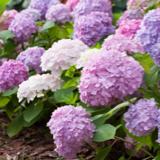
Unique looking succulents can make your rooms look better, also, they are low-maintenance and easiest plants to grow. Check out the 14 best indoor succulents for your home!
Are you looking for the one ingredient that’s capable of making any room look much better? The answer is indoor plants. After the failure of faux plants, indoor houseplants are back in fashion, and why not. A splatter of healthy greenery in your room can make it feel instantly welcoming and fresh. Another good reason to plant indoor plants is they purify air and in turn create a healthier living place.
Also Read: Plants for a Restful Sleep
Now face it, not all houseplants are easy to grow, especially for beginners. However, succulents, when grown as houseplants, adjust well to indoor conditions and are easiest to grow. And that’s why we’ve made a selection of succulents that are popular and easiest to grow.
Also Read: The Most Easy to Grow Houseplants
1. Burro’s Tail (Sedum morganianum)
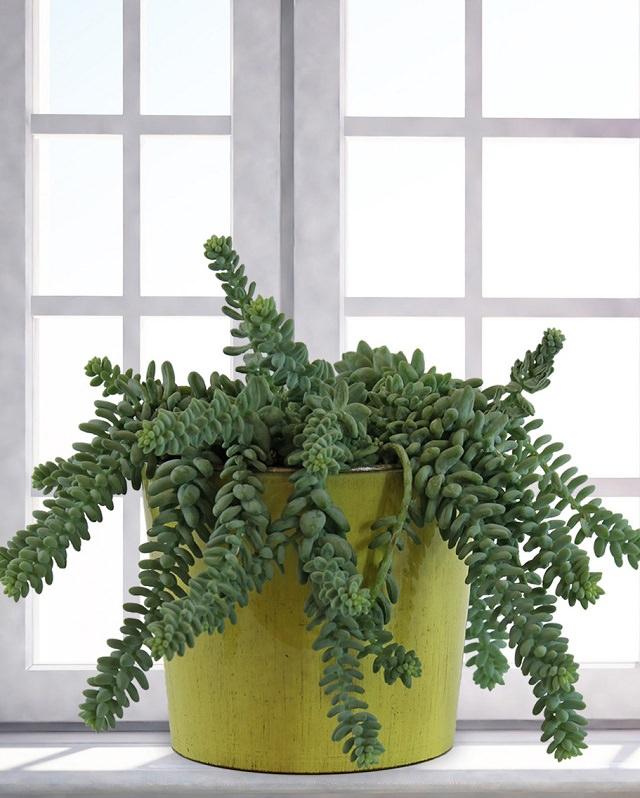
A native of Mexico, Burro’s tail is best planted in hanging baskets due to its fat trailing stems. Its beautiful gray-blue or gray-green leaves can grow up to 2 feet long. This plant does best when kept in a spot that receives bright sun.
Growing TipsLet the soil dry out between watering spells, and ensure that soil is kept on a dry side in times of winter dormancy, especially, if you’re growing it in a cool-temperate zone.Fertilize the plant once in summer using a 10:10:10 fertilizer or any cactus fertilizer.Leaves will fall off with the slightest of touches, so it is important the plant is placed where there will be a minimal disturbance.If you have to move it outside for the summer sun, ensure it will acclimate well before keeping it in a full sun.
2. Zebra Cactus (Haworthia fasciata)

Native to the African continent, the zebra plant perch on top of the soil and sports a neat for of leaves which boasts stunning horizontal white stripes. The beauty of this little plant is that it looks exceptional, takes a small space and requires little to no care.
Growing TipsUse a shallow pot since the roots don’t penetrate the soil deeply.Repot it at the interval of 12-24 months with the fresh succulent potting mix for optimum growth.Allow the soils to nearly dry out between watering spells. It’s important for all the succulents.The zebra plant is best placed in a bright spot so as not to expose the plant to the direct sun lest it becomes shriveled.
3. Aloe vera
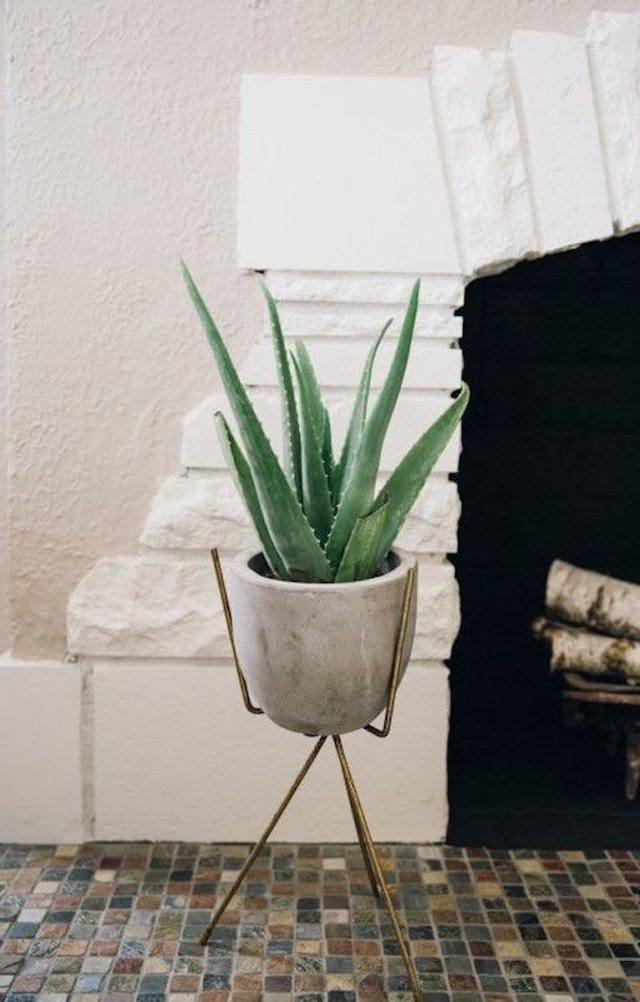
Aloe vera is a medicinal plant, a succulent whose sap has been used to treat sunburn and wounds for centuries. Medicinal value aside, aloe vera is also a great indoor plant. Because the sharp thorns along the margin of the leaves can cut people, the plant is best placed somewhere it can’t be accidentally brushed or fall.
Growing TipsLet the soil dry between soakings.Put it where it can get a couple of hours of sunlight daily.Fertilize the plant twice during the growing season using a balanced 10:10:10 fertilizer but don’t fertilize in winter.Do not repot unless the roots start to push their way out of the pot.
Also Read: How to Care for an Aloe Plants
4. Crown of Thorns (Euphorbia milii)
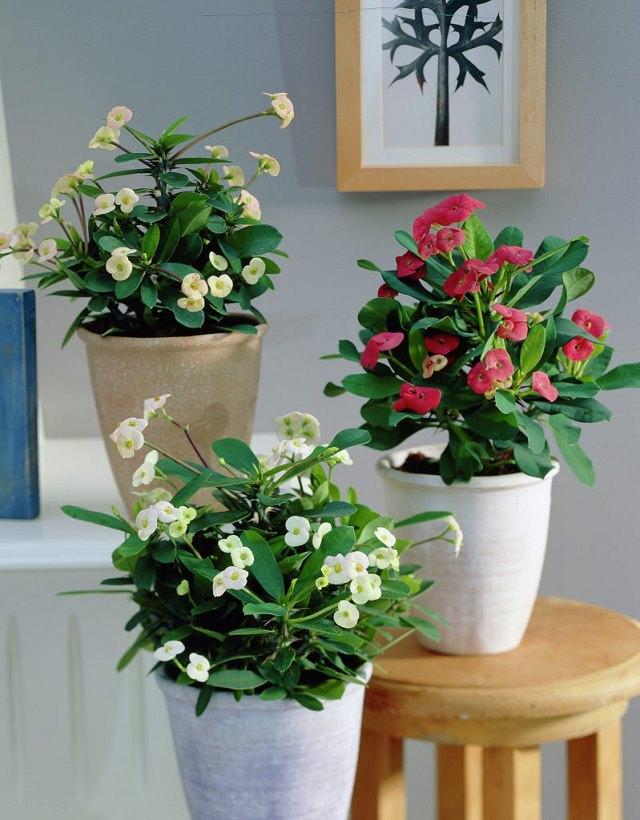
Native to Madagascar, this plant can bloom throughout the year provided you give it enough light. Long and spoon-shaped leaves appear at the end of its spiky branches, together with tiny flowers. The flowers are not noticeable because of their small size, but you will see yellow, red or salmon bracts surround them that looks attractive.
Growing TipsThis plant has low to moderate watering needs.Avoid letting the whole pot dry out or it will drop leaves.Direct light will give you the best bloom although the plant can also adapt to medium-light conditions.Fertilize 2-3 times with a balanced 10:10:10 fertilizer during the growing season.
5. Hens-and-Chicks
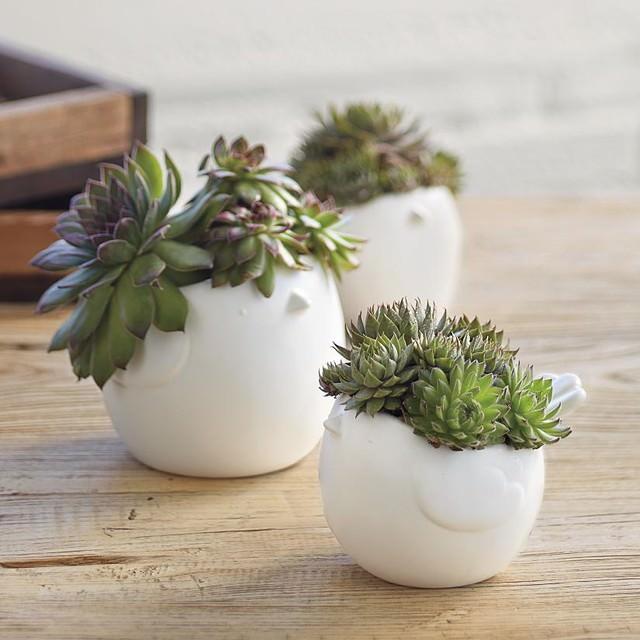
The Hens-and-Chick plants are another great succulent group of plants for indoor gardening, they form flat flowerlike rosettes that have rounded edges. These plants need to be allowed to dry a bit between watering since overwatering can cause rotting.
Growing TipsWater very infrequently during winter dormancy, if growing in a cooler region.Keep these plants in a bright spot, they can also tolerate light shade.You can propagate the plants by cuttings.
6. String of Bananas
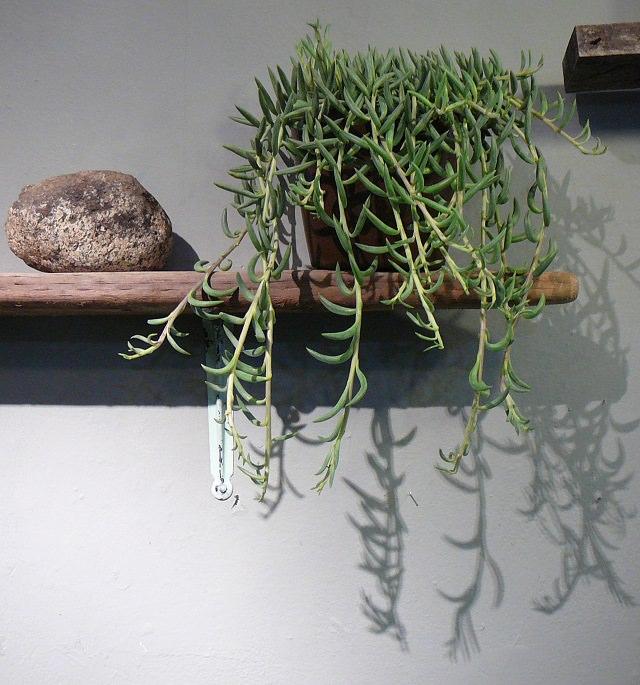
The trailing indoor succulent plant produces long tendrils of small banana-like leaves. The plant looks great when planted on its own and should be pruned regularly to grow thick and full. It also works beautifully when put in a pot containing other succulent indoor plants.
Growing TipsIt requires filtered sunlightWater the plant when soil is dry to touchIt does well in porous soil with excellent drainage.It is toxic, so you need to keep it away from pets and children who might munch it.
7. Lithops

Lithops are unique small and inconspicuous succulent plants that look like stones or pebbles. Growing lithops is very easy and don’t require much care.
Growing TipsKeep the plant in a sunny location, a south or west facing window would be best, away from drafts.Grow lithops in poor, well-drained soil.Stop watering your lithops plants in winter (in cooler zones).
8. Christmas Cactus (Schlumbergera x buckleyi)
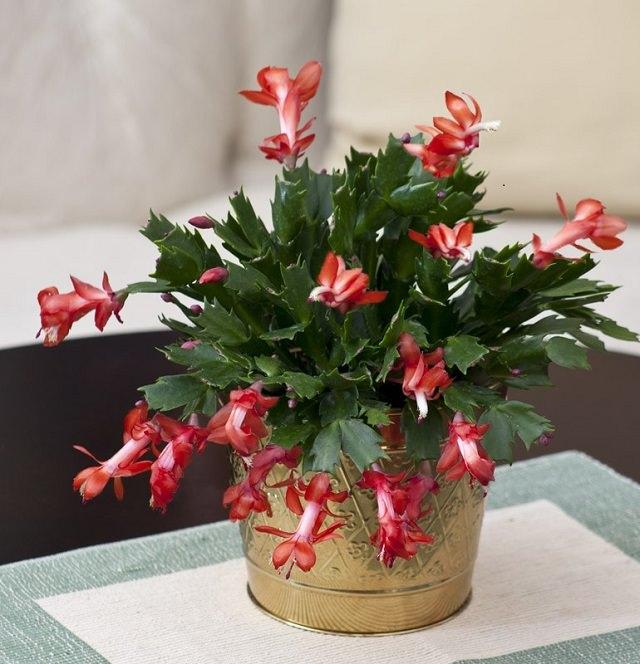
Christmas cactus needs no introduction, it is one of the most beautiful succulent plants, it looks good even without the flowers.
Growing TipsFor this plant to grow, allow the top 2 inches of the soil to dry between watering spells.Keep the plant on a dry side during winter. When it is in bud stage, be very careful since even the slightest overwatering or dehydration can lead to dropping of buds.
9. Ponytail palm (Beaucarnea recurvata)
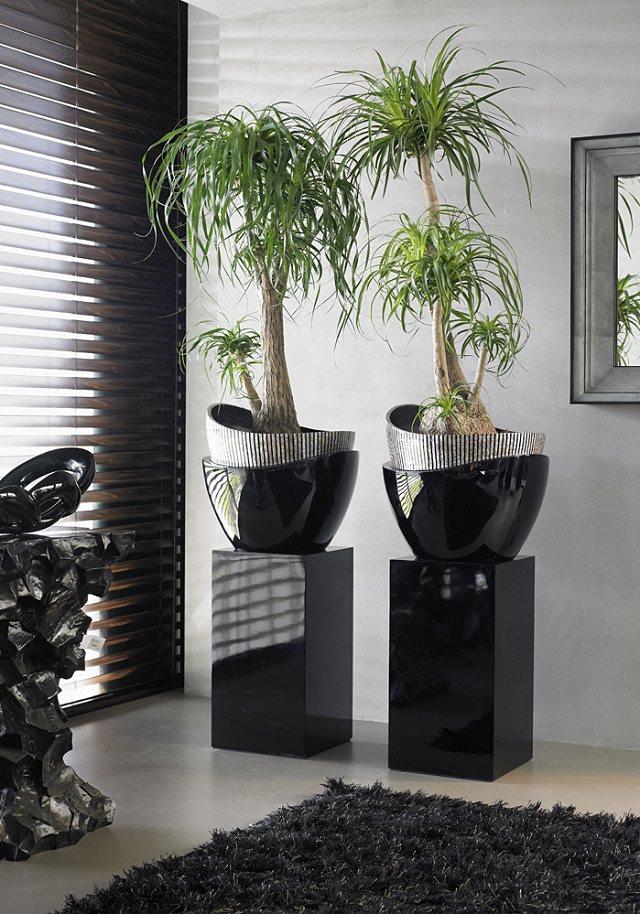
Ponytail palm is not a palm but a succulent. Probably, one of the most appealing houseplants and best in large houseplants. Its water is stored in the swollen stem base, which looks like elephant’s foot that’s why it’s also called “Elephant Foot Palm”.
Growing TipsIt grows well in sunny spots but can be grown in all day long bright indirect sunlight.It’s a plant and forget kind of plant when it comes to watering. Avoid watering regularly and let the top soil dry out before watering again.
10. Snake Plant
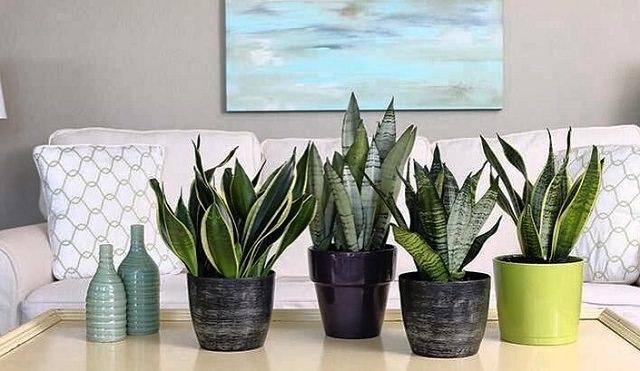
The snake plant or Mother-in-law’s tongue the most low maintenance plant in this list of best succulent plants for indoors and it is well-deserved! We also listed it in our post– Plants You can Grow without Sunlight. And why not, this succulent plant can survive in the darkest of corners and requires very low maintenance.
Growing TipsWater moderately.As snake plant is a very forgiving plant, you can place it in dim spots.
11. String of Pearls

The string of pearls is an exceptional trailing houseplant, very appealing indoors when grown in hanging baskets. You can experiment to grow it in different containers. Like other succulent houseplants growing string of pearls or beads is no different.
Growing TipsKeep the string of pearl plant in a bright light.Be careful with watering, this plant has low watering needs but in warmer regions, moderate watering is required.
12. Panda Plant (Kalanchoe tomentosa)
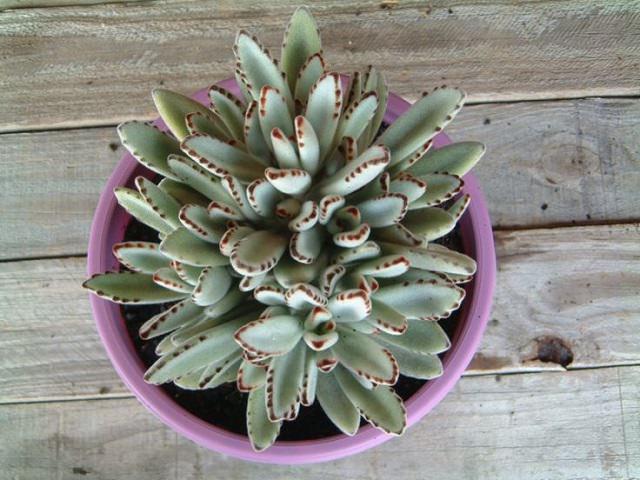
The silver gray hair of this plant makes it look fuzzy, the leaves are fat like other succulents and have rusty color on edges, like many other plants of kalanchoe genus the plant forms flowers too. However, they rarely bloom in indoor conditions.
Growing TipsKeeping the panda plant in a spot that receives bright indirect light and a couple of hours of direct sunlight is a good idea.Water infrequently and let the plant to dry out between the watering spells.Feed the plant once in a month during the growing season.Save the plant from cold and draft, normal room temperature is perfect.
13. Kalanchoe blossfeldiana
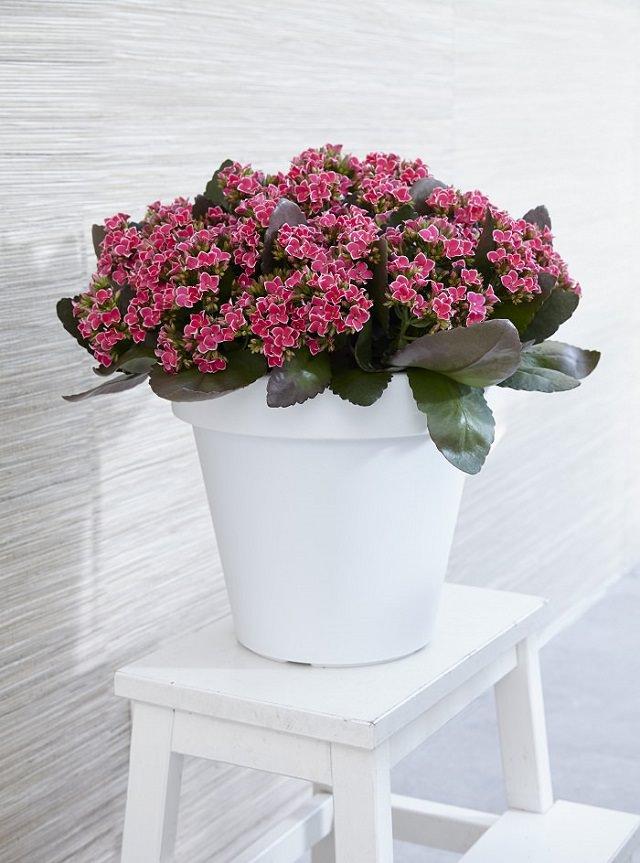
Kalanchoe blossfeldiana is one of the best flowering houseplants you can grow. Plants of this genus grow best outdoors in warm climates. However, it can be grown indoors. This flowering succulent comes in a variety of colors.
Growing TipsLow watering needs.The plant needs to be in a sunny spot to bloom.
Also Read: Flowering Houseplants
14. Pencil Cactus (Euphorbia tirucalli)

Pencil cactus became one of the most popular succulent houseplants from last few years and why not this unique African plant can grow up to 6 feet tall indoors and looks so different, quite a few houseplants like fiddle leaf fig can achieve such height.
Growing TipsKeep the plant near a sunny window.Water every couple of weeks, the plant has low watering needs.Use well-drained, gritty soil.Repot the plant every year or when you find it rootbound.
Are you looking for the one ingredient that’s capable of making any room look much better? The answer is indoor plants. After the failure of faux plants, indoor houseplants are back in fashion, and why not. A splatter of healthy greenery in your room can make it feel instantly welcoming and fresh. Another good reason to plant indoor plants is they purify air and in turn create a healthier living place.
Also Read: Plants for a Restful Sleep
Now face it, not all houseplants are easy to grow, especially for beginners. However, succulents, when grown as houseplants, adjust well to indoor conditions and are easiest to grow. And that’s why we’ve made a selection of succulents that are popular and easiest to grow.
Also Read: The Most Easy to Grow Houseplants
1. Burro’s Tail (Sedum morganianum)

A native of Mexico, Burro’s tail is best planted in hanging baskets due to its fat trailing stems. Its beautiful gray-blue or gray-green leaves can grow up to 2 feet long. This plant does best when kept in a spot that receives bright sun.
Growing TipsLet the soil dry out between watering spells, and ensure that soil is kept on a dry side in times of winter dormancy, especially, if you’re growing it in a cool-temperate zone.Fertilize the plant once in summer using a 10:10:10 fertilizer or any cactus fertilizer.Leaves will fall off with the slightest of touches, so it is important the plant is placed where there will be a minimal disturbance.If you have to move it outside for the summer sun, ensure it will acclimate well before keeping it in a full sun.
2. Zebra Cactus (Haworthia fasciata)

Native to the African continent, the zebra plant perch on top of the soil and sports a neat for of leaves which boasts stunning horizontal white stripes. The beauty of this little plant is that it looks exceptional, takes a small space and requires little to no care.
Growing TipsUse a shallow pot since the roots don’t penetrate the soil deeply.Repot it at the interval of 12-24 months with the fresh succulent potting mix for optimum growth.Allow the soils to nearly dry out between watering spells. It’s important for all the succulents.The zebra plant is best placed in a bright spot so as not to expose the plant to the direct sun lest it becomes shriveled.
3. Aloe vera

Aloe vera is a medicinal plant, a succulent whose sap has been used to treat sunburn and wounds for centuries. Medicinal value aside, aloe vera is also a great indoor plant. Because the sharp thorns along the margin of the leaves can cut people, the plant is best placed somewhere it can’t be accidentally brushed or fall.
Growing TipsLet the soil dry between soakings.Put it where it can get a couple of hours of sunlight daily.Fertilize the plant twice during the growing season using a balanced 10:10:10 fertilizer but don’t fertilize in winter.Do not repot unless the roots start to push their way out of the pot.
Also Read: How to Care for an Aloe Plants
4. Crown of Thorns (Euphorbia milii)

Native to Madagascar, this plant can bloom throughout the year provided you give it enough light. Long and spoon-shaped leaves appear at the end of its spiky branches, together with tiny flowers. The flowers are not noticeable because of their small size, but you will see yellow, red or salmon bracts surround them that looks attractive.
Growing TipsThis plant has low to moderate watering needs.Avoid letting the whole pot dry out or it will drop leaves.Direct light will give you the best bloom although the plant can also adapt to medium-light conditions.Fertilize 2-3 times with a balanced 10:10:10 fertilizer during the growing season.
5. Hens-and-Chicks

The Hens-and-Chick plants are another great succulent group of plants for indoor gardening, they form flat flowerlike rosettes that have rounded edges. These plants need to be allowed to dry a bit between watering since overwatering can cause rotting.
Growing TipsWater very infrequently during winter dormancy, if growing in a cooler region.Keep these plants in a bright spot, they can also tolerate light shade.You can propagate the plants by cuttings.
6. String of Bananas

The trailing indoor succulent plant produces long tendrils of small banana-like leaves. The plant looks great when planted on its own and should be pruned regularly to grow thick and full. It also works beautifully when put in a pot containing other succulent indoor plants.
Growing TipsIt requires filtered sunlightWater the plant when soil is dry to touchIt does well in porous soil with excellent drainage.It is toxic, so you need to keep it away from pets and children who might munch it.
7. Lithops

Lithops are unique small and inconspicuous succulent plants that look like stones or pebbles. Growing lithops is very easy and don’t require much care.
Growing TipsKeep the plant in a sunny location, a south or west facing window would be best, away from drafts.Grow lithops in poor, well-drained soil.Stop watering your lithops plants in winter (in cooler zones).
8. Christmas Cactus (Schlumbergera x buckleyi)

Christmas cactus needs no introduction, it is one of the most beautiful succulent plants, it looks good even without the flowers.
Growing TipsFor this plant to grow, allow the top 2 inches of the soil to dry between watering spells.Keep the plant on a dry side during winter. When it is in bud stage, be very careful since even the slightest overwatering or dehydration can lead to dropping of buds.
9. Ponytail palm (Beaucarnea recurvata)

Ponytail palm is not a palm but a succulent. Probably, one of the most appealing houseplants and best in large houseplants. Its water is stored in the swollen stem base, which looks like elephant’s foot that’s why it’s also called “Elephant Foot Palm”.
Growing TipsIt grows well in sunny spots but can be grown in all day long bright indirect sunlight.It’s a plant and forget kind of plant when it comes to watering. Avoid watering regularly and let the top soil dry out before watering again.
10. Snake Plant

The snake plant or Mother-in-law’s tongue the most low maintenance plant in this list of best succulent plants for indoors and it is well-deserved! We also listed it in our post– Plants You can Grow without Sunlight. And why not, this succulent plant can survive in the darkest of corners and requires very low maintenance.
Growing TipsWater moderately.As snake plant is a very forgiving plant, you can place it in dim spots.
11. String of Pearls

The string of pearls is an exceptional trailing houseplant, very appealing indoors when grown in hanging baskets. You can experiment to grow it in different containers. Like other succulent houseplants growing string of pearls or beads is no different.
Growing TipsKeep the string of pearl plant in a bright light.Be careful with watering, this plant has low watering needs but in warmer regions, moderate watering is required.
12. Panda Plant (Kalanchoe tomentosa)

The silver gray hair of this plant makes it look fuzzy, the leaves are fat like other succulents and have rusty color on edges, like many other plants of kalanchoe genus the plant forms flowers too. However, they rarely bloom in indoor conditions.
Growing TipsKeeping the panda plant in a spot that receives bright indirect light and a couple of hours of direct sunlight is a good idea.Water infrequently and let the plant to dry out between the watering spells.Feed the plant once in a month during the growing season.Save the plant from cold and draft, normal room temperature is perfect.
13. Kalanchoe blossfeldiana

Kalanchoe blossfeldiana is one of the best flowering houseplants you can grow. Plants of this genus grow best outdoors in warm climates. However, it can be grown indoors. This flowering succulent comes in a variety of colors.
Growing TipsLow watering needs.The plant needs to be in a sunny spot to bloom.
Also Read: Flowering Houseplants
14. Pencil Cactus (Euphorbia tirucalli)

Pencil cactus became one of the most popular succulent houseplants from last few years and why not this unique African plant can grow up to 6 feet tall indoors and looks so different, quite a few houseplants like fiddle leaf fig can achieve such height.
Growing TipsKeep the plant near a sunny window.Water every couple of weeks, the plant has low watering needs.Use well-drained, gritty soil.Repot the plant every year or when you find it rootbound.
8
9








